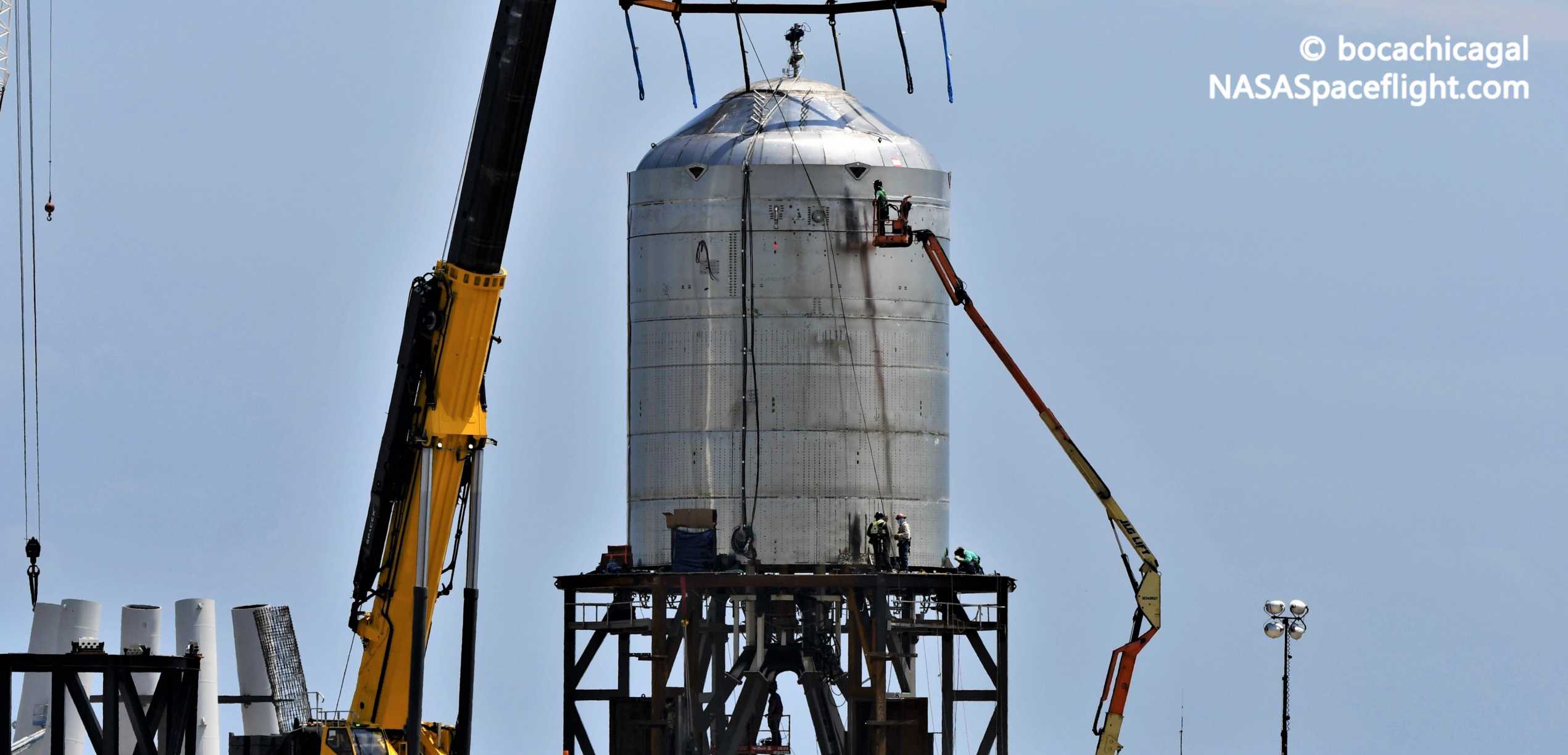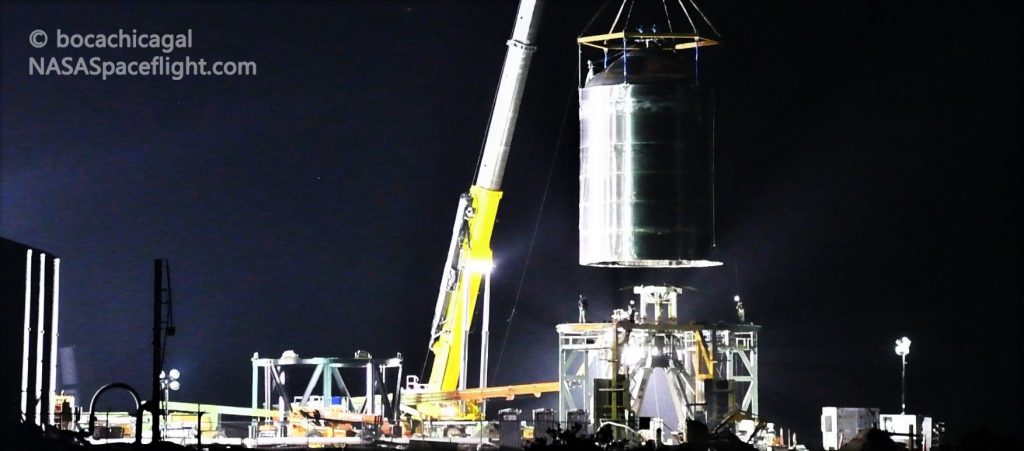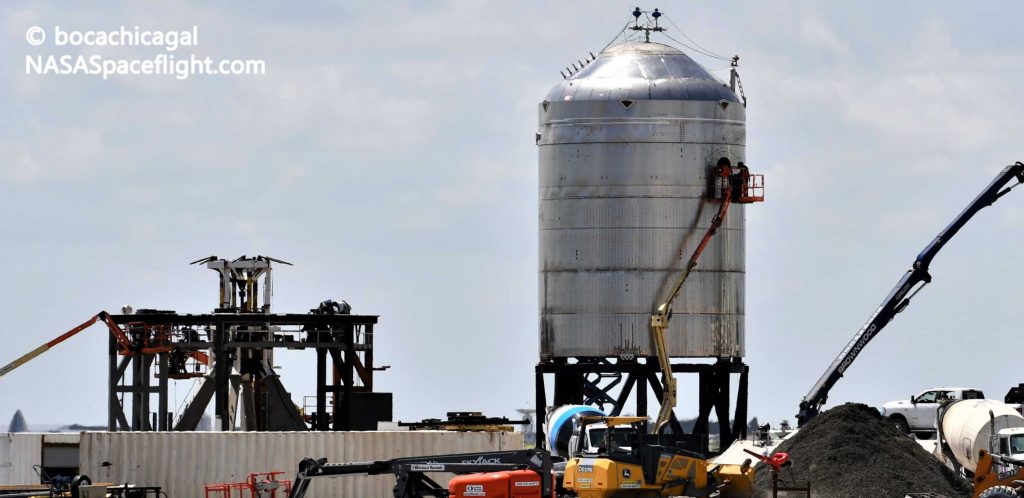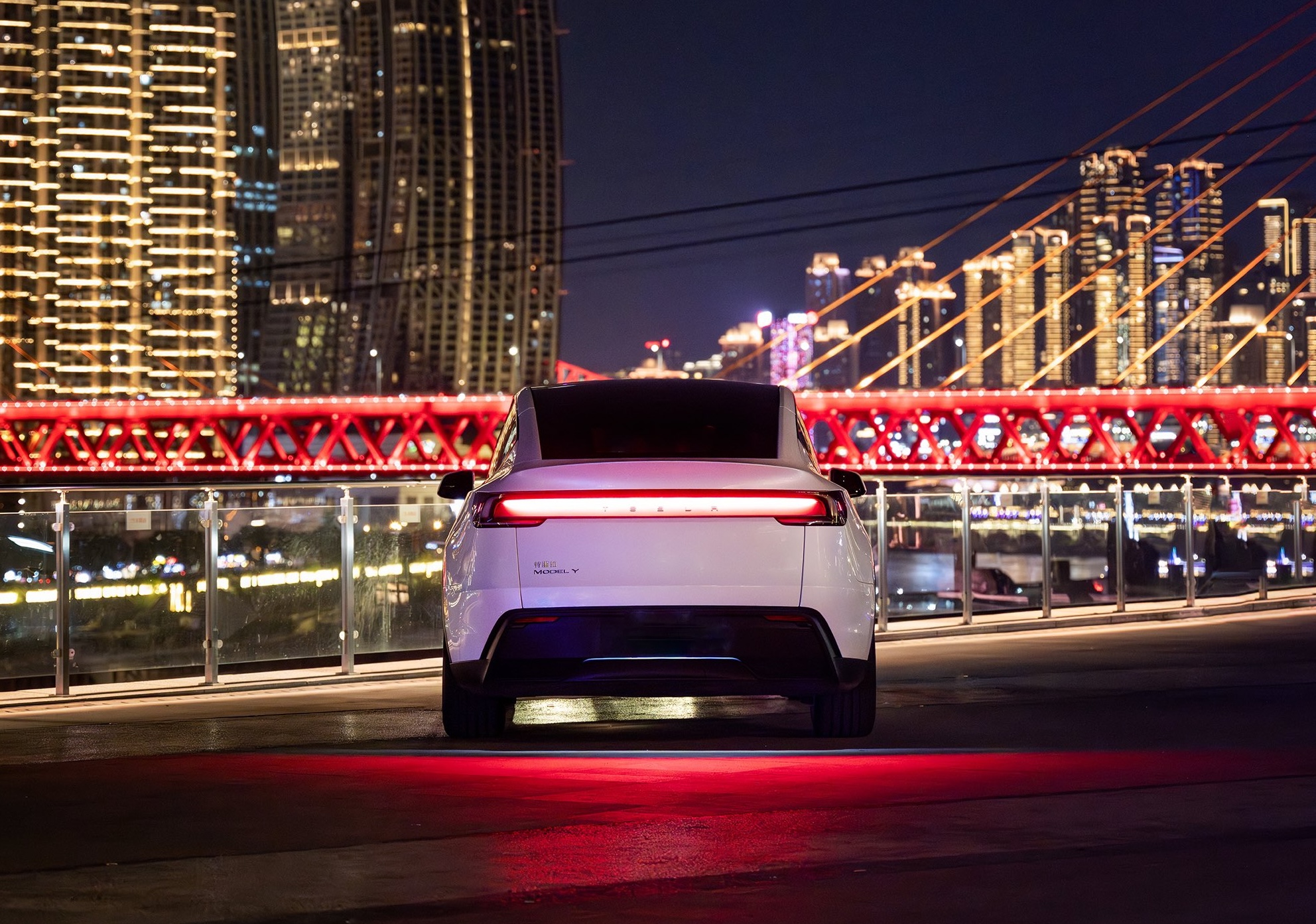

News
SpaceX Starship test tank set for destructive finale after ‘cryo proof’
SpaceX’s fourth Starship test tank is set for a destructive finale after completing a “cryo proof” pressure test on Thursday.
SpaceX’s newest Starship test tank – SN7.1 – is the second in a series of two planned prototypes, both designed to test the viability of using a new steel alloy to build future Starships and Super Heavy boosters. CEO Elon Musk says that SpaceX is technically customizing its own steel alloy for Starship production but Musk’s comments and the results from SN7 testing in June 2020 point towards an offshoot of 304L with minor metallurgical tweaks.
Prior to SN7’s test campaign, Musk revealed that the main goal of the new alloy was to reduce the brittleness of Starship tanks and any adjacent steel components under cryogenic conditions (i.e. extreme cold). Ultimately, SN7 appeared to confirm that the new alloy’s behavior was far more forgiving under cryogenic loads, reaching what were believed to be record pressures before the tank finally burst on June 24th.
Following in SN7’s footsteps, SN7.1 is much closer to an actual Starship prototype.
“SN7.1 is significantly more complex than its sibling and will test a ~304L Raptor mount (thrust puck) and skirt section. The forces and general conditions those new parts will be subjected to are substantially different than most of what SN7 was subjected to, meaning that there is a chance that 304L steel is actually worse in some scenarios.
With any luck, though, SN7.1’s test campaign – scheduled to begin as early as 9pm CDT (UTC-5), September 10th – will be a flawless success, proving that SpaceX’s new steel alloy is superior to 301 for all Starship-related applications. If that’s the case, Starship SN8 – the first full new-alloy prototype – will likely be fully outfitted with a nosecone and header tanks before beginning acceptance testing later this month.”
Teslarati.com — September 10th, 2020
For SN7.1, increased ductility could theoretically be a mixed bag. Assuming SpaceX has also built the thrust puck out of 304L-adjacent steel, it may end up being too squishy under the extreme forces it will be subjected to. At full throttle, the thrust of three Raptor engines will compress the thrust puck – a cone with dimensions roughly the same as a large circular table – with the equivalent force of a ~600 metric ton (1.3 million lb) weight.

On September 10th, SpaceX put SN7.1 through its paces, performing a cryogenic proof test with liquid nitrogen (LN2) while the tank was still installed on the simple steel frame used to support it during production and transport. That simple decision offers a brief glimpse at the extensive planning that allows SpaceX to optimize for speed and efficiency while still conducting successful tests. While SpaceX could have technically installed SN7.1 directly onto a brand new launch mount custom-built for the exact kind of testing expected, the company instead left the tank on its build stand – much cheaper and far easier to replace than the former.
Technically, moving directly to the launch mount would have slightly simplified the test process, but a tank rupture during a routine cryogenic proof test could have extensively damaged or destroyed the mount, requiring weeks of work to build a full replacement. After SN7.1 successfully completed a cryogenic pressure test on September 10th, SpaceX simply lifted it off its work stand and installed it on a custom-built launch mount.

As early as 9pm CDT (UTC-5) on September 14th, SpaceX will once again load SN7.1 with liquid nitrogen. This time around, the tank – after reaching flight pressures of 7.5 to 8+ bar (110-120+ psi) – will be subjected to the simulated thrust of three Raptor engines by a series of hydraulic rams. Based on a public schedule of road closures, at least two tests are planned. The first will likely put SN7.1 through a range of Raptor thrust scenarios and profiles under the same tank pressures needed for orbital Starship flights. If that test is successful, SpaceX may move SN7.1 back to its work stand before intentionally pressurizing the tank until it bursts sometime around September 17th.
Check out Teslarati’s Marketplace! We offer Tesla accessories, including for the Tesla Cybertruck and Tesla Model 3.
News
Tesla China breaks 8-month slump by selling 71,599 vehicles wholesale in June
Tesla China’s June numbers were released by the China Passenger Car Association (CPCA) on Tuesday.

Tesla China was able to sell 71,599 vehicles wholesale in June 2025, reversing eight consecutive months of year-over-year declines. The figure marks a 0.83% increase from the 71,599 vehicles sold wholesale in June 2024 and a 16.1% jump compared to the 61,662 vehicles sold wholesale in May.
Tesla China’s June numbers were released by the China Passenger Car Association (CPCA) on Tuesday.
Tesla China’s June results in focus
Tesla produces both the Model 3 and Model Y at its Shanghai Gigafactory, which serves as the company’s primary vehicle export hub. Earlier this year, Tesla initiated a changeover for its best-selling vehicle, the Model Y, resulting in a drop in vehicle sales during the first and second quarters.
Tesla’s second-quarter China sales totaled 191,720 units including exports. While these numbers represent a 6.8% year-over-year decline for Tesla China, Q2 did show sequential improvement, rising about 11% from Q1 2025, as noted in a CNEV Post report.
For the first half of the year, Tesla sold 364,474 vehicles wholesale. This represents a 14.6% drop compared to the 426,623 units sold wholesale in the first half of 2024.
China’s competitive local EV market
Tesla’s position in China is notable, especially as the new Model Y is gaining ground in the country’s BEV segment. That being said, Tesla is also facing competition from impressive local brands such as Xiaomi, whose new YU7 electric SUV is larger and more affordable than the Model Y.
The momentum of the YU7 is impressive, as the vehicle was able to secure 200,000 firm orders within three minutes and over 240,000 locked-in orders within 18 hours. Xiaomi’s previous model, the SU7 electric sedan, which is aimed at the Tesla Model 3, also remains popular, with June deliveries surpassing 25,000 units for the ninth straight month.
While China’s EV market is getting more competitive, Tesla’s new Model Y is also ramping its production and deliveries. Needless to say, Tesla China’s results for the remaining two quarters of 2025 will be very interesting.
Elon Musk
Tesla reveals it is using AI to make factories more sustainable: here’s how
Tesla is using AI in its Gigafactory Nevada factory to improve HVAC efficiency.

Tesla has revealed in its Extended Impact Report for 2024 that it is using Artificial Intelligence (AI) to enable its factories to be more sustainable. One example it used was its achievement of managing “the majority of the HVAC infrastructure at Gigafactory Nevada is now AI-controlled” last year.
In a commitment to becoming more efficient and making its production as eco-friendly as possible, Tesla has been working for years to find solutions to reduce energy consumption in its factories.
For example, in 2023, Tesla implemented optimization controls in the plastics and paint shops located at Gigafactory Texas, which increased the efficiency of natural gas consumption. Tesla plans to phase out natural gas use across its factories eventually, but for now, it prioritizes work to reduce emissions from that energy source specifically.
It also uses Hygrometric Control Logic for Air Handling Units at Giafactory Berlin, resulting in 17,000 MWh in energy savings each year. At Gigafactory Nevada, Tesla saves 9.5 GWh of energy through the use of N-Methylpyrrolidone refineries when extracting critical raw material.
Perhaps the most interesting way Tesla is conserving energy is through the use of AI at Gigafactory Nevada, as it describes its use of AI to reduce energy demand:
“In 2023, AI Control for HVAC was expanded from Nevada and Texas to now include our Berlin-Brandenburg and Fremont factories. AI Control policy enables HVAC systems within each factory to work together to process sensor data, model factory dynamics, and apply control actions that safely minimize the energy required to support production. In 2024, this system achieved two milestones: the majority of HVAC infrastructure at Gigafactory Nevada is now AI-controlled, reducing fan and thermal energy demand; and the AI algorithm was extended to manage entire chiller plants, creating a closed-loop control system that optimizes both chilled water consumption and the energy required for its generation, all while maintaining factory conditions.”
Tesla utilizes AI Control “primarily on systems that heat or cool critical factory production spaces and equipment.” AI Control communicates with the preexisting standard control logic of each system, and any issues can be resolved by quickly reverting back to standard control. There were none in 2024.
Tesla says that it is utilizing AI to drive impact at its factories, and it has proven to be a valuable tool in reducing energy consumption at one of its facilities.
Elon Musk
Tesla analysts believe Musk and Trump feud will pass
Tesla CEO Elon Musk and U.S. President Donald Trump’s feud shall pass, several bulls say.

Tesla analysts are breaking down the current feud between CEO Elon Musk and U.S. President Donald Trump, as the two continue to disagree on the “Big Beautiful Bill” and its impact on the country’s national debt.
Musk, who headed the Department of Government Efficiency (DOGE) under the Trump Administration, left his post in May. Soon thereafter, he and President Trump entered a very public and verbal disagreement, where things turned sour. They reconciled to an extent, and things seemed to be in the past.
However, the second disagreement between the two started on Monday, as Musk continued to push back on the “Big Beautiful Bill” that the Trump administration is attempting to sign into law. It would, by Musk’s estimation, increase spending and reverse the work DOGE did to trim the deficit.
Every member of Congress who campaigned on reducing government spending and then immediately voted for the biggest debt increase in history should hang their head in shame!
And they will lose their primary next year if it is the last thing I do on this Earth.
— Elon Musk (@elonmusk) June 30, 2025
President Trump has hinted that DOGE could be “the monster” that “eats Elon,” threatening to end the subsidies that SpaceX and Tesla receive. Musk has not been opposed to ending government subsidies for companies, including his own, as long as they are all abolished.
How Tesla could benefit from the ‘Big Beautiful Bill’ that axes EV subsidies
Despite this contentious back-and-forth between the two, analysts are sharing their opinions now, and a few of the more bullish Tesla observers are convinced that this feud will pass, Trump and Musk will resolve their differences as they have before, and things will return to normal.
ARK Invest’s Cathie Wood said this morning that the feud between Musk and Trump is another example of “this too shall pass:”
BREAKING: CATHIE WOOD SAYS — ELON AND TRUMP FEUD “WILL PASS” 👀 $TSLA
She remains bullish ! pic.twitter.com/w5rW2gfCkx
— TheSonOfWalkley (@TheSonOfWalkley) July 1, 2025
Additionally, Wedbush’s Dan Ives, in a note to investors this morning, said that the situation “will settle:”
“We believe this situation will settle and at the end of the day Musk needs Trump and Trump needs Musk given the AI Arms Race going on between the US and China. The jabs between Musk and Trump will continue as the Budget rolls through Congress but Tesla investors want Musk to focus on driving Tesla and stop this political angle…which has turned into a life of its own in a roller coaster ride since the November elections.”
Tesla shares are down about 5 percent at 3:10 p.m. on the East Coast.
-

 Elon Musk2 days ago
Elon Musk2 days agoTesla investors will be shocked by Jim Cramer’s latest assessment
-

 News7 days ago
News7 days agoTesla Robotaxi’s biggest challenge seems to be this one thing
-

 News2 weeks ago
News2 weeks agoTesla’s Grok integration will be more realistic with this cool feature
-

 Elon Musk2 weeks ago
Elon Musk2 weeks agoElon Musk slams Bloomberg’s shocking xAI cash burn claims
-

 News2 weeks ago
News2 weeks agoTesla China roars back with highest vehicle registrations this Q2 so far
-

 News2 weeks ago
News2 weeks agoTexas lawmakers urge Tesla to delay Austin robotaxi launch to September
-

 News2 weeks ago
News2 weeks agoTesla dominates Cars.com’s Made in America Index with clean sweep
-

 Elon Musk1 week ago
Elon Musk1 week agoFirst Look at Tesla’s Robotaxi App: features, design, and more




















